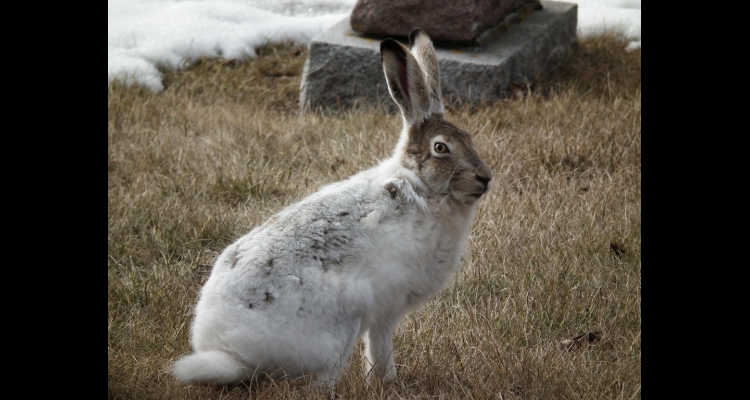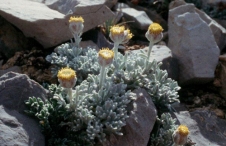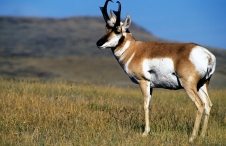Hares of Nevada
There are three species of hares (genus Lepus) native to Nevada: the blacktail jackrabbit (Lepus californicus), the whitetail jackrabbit (Lepus townsendii), and the snowshoe hare (Lepus americanus). Of these, the blacktail is the most widely distributed within the state.
Commonly seen dashing across roads or zigzagging through sagebrush, the blacktail jackrabbit is found throughout the state up to about 12,500 ft. (3,800 m) in elevation. They are light brown/grey with long, brown ears with black tips and a large tail that is black on top and buff on the bottom. They weigh from 3-7 lbs. (1.3-3.1 kg). Jackrabbits are most active from dusk till dawn, and during the day they generally lie crouched in a form (a shallow depression in the ground). When approached they remain motionless and often go unnoticed. However, if they feel threatened jackrabbits will suddenly explode from their resting spot. They use both this element of surprise and their great speed to elude predators. A blacktail can leap up to 23 ft. (7 m) and reach top speeds of 22-30 mph (35-48 km/h).
Some years jackrabbits are plentiful and seem to be everywhere, while in other years they are rarely seen. Blacktail jackrabbit populations can undergo dramatic fluctuations, and densities have been recoded as high as 1,500 animals per square km. During population increases jackrabbits can do considerable damage to agricultural fields as well as to forest plantations and young fruit trees. Jackrabbits eat almost constantly and can consume large quantities relative to their size. During the spring and summer they usually feed on available grasses and shrubs, while during the fall and winter they eat twigs and bark. Jackrabbit populations also can decrease quickly. In some years more then 90% of populations in the western United States die from tularemia, also known as “rabbit fever,” which is caused by the highly infectious Francisella tularensis bacterium. However, due to their high fertility, blacktail jackrabbit numbers can recover quickly from these die-offs.
While the blacktail jackrabbit is associated with sagebrush, the whitetail jackrabbit is usually associated with grassland communities. In Nevada they are found in the Carson Range (a spur range of the Sierra Nevada) and in the northern and northeastern portions of the state up to 14,000 ft. (4,300 m) in elevation. The whitetail jackrabbit is the largest of Nevada's hares. It weighs from 4.4-9 lbs. (2-4 kg) and is 18-22 in. (46-56 cm) in length. In summer the whitetail jackrabbit looks similar in color to the blacktail jackrabbit except for the underside of the tail, which in the whitetail is always white. During winter, in the colder parts of its range, the whitetail molts and turns white.
Whitetail jackrabbits are an important prey source for medium-sized predators such as bobcats and coyotes. They also impact vegetation community composition through their grazing. Whitetail jackrabbits are sometimes viewed as a threat by farmers because they can destroy crops, eat hay stores, and, in times of low food resources, girdle trees. However, whitetails were a significant food source for early settlers and continue to be a year round game animal. Their pelts are highly prized and widely used in the commercial fur industry.
There has been an exodus of the whitetail from the south and east over the past century due to increased agriculture and competition from the blacktail jackrabbit. Because whitetail jackrabbits prefer open grasslands, and on ranges where grasses have been replaced by shrubs blacktail jackrabbits tend to replace whitetails. In the Great Basin, reduced fire frequency due to fire suppression and grazing has allowed many grassland valleys to be converted to sagebrush. Thus the whitetail is no longer as abundant as it once was. However, an accompanying range increase to the north also has been observed. Warming temperatures may be allowing whitetail jackrabbits to live in areas that previously were not habitable for them.
The snowshoe hare is the smallest hare found in Nevada. They range in length from 13-18 in. (33-46 cm) and usually weigh between 2-4 lbs. (0.9-1.8 kg). Unlike the two other hares, snowshoe hares have ears that are shorter than their head; therefore, they look similar to cottontail rabbits. Like the whitetail jackrabbit, the snowshoe hare goes through two annual molts. In early winter it turns white, except for the tips of its ears, which remain black. In late spring it molts again to a summer coat of grayish brown.
Snowshoe hares are most often found in fields and coniferous forests in the western mountains. In Nevada they are restricted to the Carson Range. They browse on green grasses, forbs, and new growth on trees during spring and summer; during the winter they forage on buds, twigs, and bark of deciduous trees and evergreens.
Like the blacktail jackrabbit, snowshoe hares also undergo dramatic population cycles. Population densities can vary from approximately 1 to 4,000 hares per square km. The magnitude of the population fluctuations is greatest in the northern portions of the hares' range and smallest in the southern portions. Disease and predation most likely play major roles in the population fluctuations.
Article Locations
Related Articles
Further Reading
None at this time.




